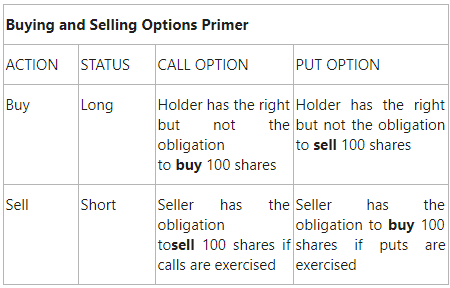How To Trade Options Primer
Many investors ask about the terminology of options and the difference between types of options. Here I share some background o the fundamentals of option trading. Bonus: An active option trade is shown below for our Covered Call of the Week.
An option is a standardized contract originated by the Options Clearing Corporation (OCC) that is exchange-listed. A stock option is the legal right, but not obligation, to buy (calls) or sell (puts) shares of a specific stock, which is known as the underlying stock, for a fixed time and a fixed price. Stock options have two main characteristics:
Fixed Price: an option give the holder the right to buy or sell at a fixed price. This price is known as an exercise price or strike price (or just “strike”).
Limited Life: an option is good for only a specific period of time, then expires. If it expires without being exercised, it is said to “expire worthless”.
The Two Types of Options
There are two types of options to be used in your option strategy for various trades based on the prediction of the investor.
Calls: the right, but not the obligation, to buy the underlying stock.
Puts: The right, but not the obligation, to sell the underlying stock.
(Click on image to enlarge)

Underlying Stock – these are the shares of stock that underlie (are subject to) a stock option. The underlying stock also can be an Exchange-Traded Fund (ETF) instead of a stock.
Option Contract – each exchange-listed call or put contract normally covers 100 shares. The only exception would be for a stock or reverse split, merger or other corporate recapitalization, which can result in an adjustment to the terms of an option contracts. There are over-the-counter options, but they are a different subject and not covered in this article.
Option Trading – standardized options contracts are exchange-listed and traded on the different U.S. option exchanges.
Expiration – stock options (equity options) expire on the Saturday following the 3rd Friday of each month and that Friday is the last day on which those options can trade. If the 3rd Friday is a holiday, the last trading day will be the Thursday before. Some brokerage firms institute a Friday deadline for notice of exercise by retail customers so be clear on whether you can exercise options on expiration day. Be aware that options you have sold can be exercised on expiration day.
Option Term – stock options have a life of 9 months or less unless they are LEAP options with a much longer life, up to three years. At the end of the term, the option expires.
Open Interest – the number of contracts of an option series outstanding. A proxy for how much interest among investors in this contract.
There is no risk that upon exercise of an option the other side will fail to perform. The OCC, the world’s largest clearing organization for options, processes all sales of put and call options and all option exercises. The OCC acts as the guarantor of every option transaction to ensure there are no option defaults.
In fact, there has never been a default in buying or selling shares upon call or put exercise, for this very reason. The OCC does not guarantee anyone a profit, however, only that shares will be bought (sold) upon call (put) exercise. Note that buyers and sellers of options do not form a contract with each other, there contract is with the OCC, which is the true counterparty to the option buyer or seller.
COVERED CALL of the WEEK
Covered Call on Baker Hughes (BHGE)
STRATEGY: The BHGE Sep 20, 2019, covered call with a $21.00 strike price could potentially yield a 4.69% return if BHGE stays above $21.00 a share at expiration 33 days from now. The return covered call has a 3 Key (Moderate Relative Risk) ranking while the diagonal spread has a riskier 2 Key (Considerable Relative Risk) ranking. On 08/05/19, Argus Research set a $30.00 12-Month price target for BHGE, which is currently trading at $8.94 below that target. By using this covered call strategy potential returns may be higher than simply holding the stock if BHGE stays below $22.05 through Sep 20, 2019. The covered call strategy offers limited protection if the stock drops in price, but if the stock goes below $20.06 expect losses.
CHART: the RSI is below 30. It could either mean that the stock is in a lasting downtrend or just oversold and therefore bound to retrace (look for bullish divergence in this case). The MACD is below its signal line and negative. The configuration is negative. Moreover, the share stands below its 20 and 50 day MA (respectively at 23.89 and 23.99). Finally, Baker Hughes a GE Company is trading below its lower daily Bollinger band (standing at 21.76) so expect a rebound. Baker Hughes a GE Company is currently trading near its 52-week low at 20.09 reached on 26/12/18.
Follow us on Twitter – @GetRichStayRich. Join the Monthly Income ...
more


